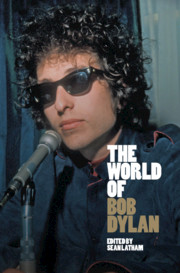Book contents
- The World of Bob Dylan
- The World of Bob Dylan
- Copyright page
- Contents
- Contributors
- Acknowledgments
- Introduction: Time to Say Goodbye Again
- Part I Creative Life
- Chapter 1 A Chronology of Bob Dylan’s Life
- Chapter 2 The Biographies
- Chapter 3 Songwriting
- Chapter 4 The Singles: A Playlist for Framing Dylan’s Recording Art
- Part II Musical Contexts
- Part III Cultural Contexts
- Part IV Political Contexts
- Part V Reception and Legacy
- Further Reading
- Index
Chapter 3 - Songwriting
from Part I - Creative Life
Published online by Cambridge University Press: 21 April 2021
- The World of Bob Dylan
- The World of Bob Dylan
- Copyright page
- Contents
- Contributors
- Acknowledgments
- Introduction: Time to Say Goodbye Again
- Part I Creative Life
- Chapter 1 A Chronology of Bob Dylan’s Life
- Chapter 2 The Biographies
- Chapter 3 Songwriting
- Chapter 4 The Singles: A Playlist for Framing Dylan’s Recording Art
- Part II Musical Contexts
- Part III Cultural Contexts
- Part IV Political Contexts
- Part V Reception and Legacy
- Further Reading
- Index
Summary
“Where do the words come from?” Bob Dylan has been asked some version of this question hundreds of times over the years by journalists, fans, and critics, all hoping to glimpse the origin of his seemingly boundless capacity for lyrical invention. When he first arrived on the New York folk music scene, Dylan typically responded by inventing an ever-more colorful history for himself and attributed some of his early tunes to a life lived on the road. He claimed, for example, to have studied at the feet of a nameless Chicago bluesman after running away from home and also suggested that he gathered material from his (entirely fictitious) years spent working in traveling circuses and carnivals.1 In 1962, just after the release of his first album, he playfully fended off Cynthia Gooding’s initial attempts to explore his creative process by complaining about the studio temperature when she asked how much of “Fixin’ to Die” he had written. When she got him back on track and again pressed the question, Dylan unwound a tale about a woman working in a side show known as the “elephant lady” before explaining that he wrote a song about her called “Won’t You Buy a Postcard” but somehow lost it. Two months later, he employed similar tactics with Pete Seeger when the leader of the folk movement asked about “some of the songs Bob Dylan has made up.” The young man again squirmed a bit before claiming that “I write a lotta stuff. In fact, I wrote five songs last night, but I gave all the papers away … someplace.”2
- Type
- Chapter
- Information
- The World of Bob Dylan , pp. 31 - 45Publisher: Cambridge University PressPrint publication year: 2021
- 1
- Cited by

